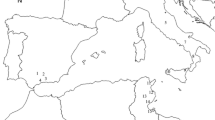Abstract
Olives are one of the largest crops in the Mediterranean region, especially in Andalusia, in southern Spain. A thermal model has been developed for forecasting the start of the olive tree pollen season at five localities in Andalusia: Cordoba, Priego, Jaen, Granada and Malaga using airborne pollen and meteorological data from 1982 to 2001. Threshold temperatures varied between 5°C and 12.5°C depending on bio-geographical characteristics. The external validity of the results was tested using the data for the year 2002 as an independent variable and it confirmed the model’s accuracy with only a few days difference from predicted values. All the localities had increasingly earlier start dates during the study period. This could confirm that olive flower phenology can be considered as a sensitive indicator of the effects of climate fluctuations in the Mediterranean area. The theoretical impact of the predicted climatic warming on the olive’s flowering phenology at the end of the century is also proposed by applying Regional Climate Model data. A general advance, from 1 to 3 weeks could be expected, although this advance will be more pronounced in mid-altitude inland areas.

Similar content being viewed by others
References
Ahmad QK (2001) Climate change 2001: impacts, adaptation, and vulnerability. In: IPCC Working Group II (ed) Summary for policymakers. IPCC
Alba F, de la Guardia CD (1998) The effect of air temperature on the starting dates of the Ulmus, Platanus and Olea pollen season in the SE Iberian Peninsula. Aerobiologia 14:191–194
Aron R (1983) Availability of chilling temperatures in California. Agric Meteorol 28:351–363
Chuine I, Cour P (1999) Climatic determinants of budburst seasonality in four temperate-zone tree species. New Phytol 143:339–349
Chuine I, Cour P, Rousseau DD (1998) Fitting models predicting dates of flowering of temperate-zone trees using simulated annealing. Plant Cell Environ 21:455–466
Chuine I, Cour P, Rousseau DD (1999) Selecting models to predict the timing of flowering of temperate trees: implications for tree phenology modelling. Plant Cell Environ 22:1–13
Dominguez-Vilches E, Galan C, Guerra F, Villamandos F, Infante F, Mediavilla A (1993) Spring pollen and related allergies in southern Spain. J Investig Allergol Clin Immunol 5:271–275
Domínguez-Vilches E, Galán C, Villamandos F, Infante F (1992) Handling and evaluation of the data from the aerobiological sampling. Monogr REA/EAN 1:1–13
D’Odorico P, Yoo JC, Jaeger S (2002) Changing seasons: a effect of the north atlantic osciallation? Am Meteorol Soc 15:435–445
Fornaciari M, Pieroni L, Ciuchi P, Romano B (1998) A regression model for the start of the pollen season in Olea europaea L. Grana 37:110–113
Fornaciari M, Pieroni L, Orlandi F, Romano B (2002) A new approach to consider the pollen variable in forecasting yield models. Econ Bot 56:66–72
Galán C, García-Mozo H, Cariñanos P, Alcázar P, Domínguez E (2001) The role of temperature in the onset of the Olea europaea L. pollen season in southwestern Spain. Int J Biometeorol 45:8–12
Galán C, Vázquez L, García-Mozo H, Domínguez E (2004) Forecasting olive (Olea europaea) crop yield based on pollen emission. Field Crops Res 86:43–51
García-Mozo H, Galán C, Aira MJ, Belmonte J, De La Guardia CD, Fernández D, Gutierrez AM, Rodriguez FJ, Trigo MM, Dominguez-Vilches E (2002) Modelling start of oak pollen season in different climatic zones in Spain. Agric For Meteorol 110:247–257
González-Minero FJ, Candau P (1996) Prediction of the beginning of the olive full pollen season in south-west Spain. Aerobiologia 12:91–96
Hirst JM (1952) An automatic volumetric spore-trap. Ann Appl Biol 36:257–265
Jones PD (2001) The Hadley Centre regional climate modelling system. PRECIS. Providing regional climates for impact studies. Meteorological Office, Hadley Centre, Berkshire
Jones PD, New M, Parker DE, Martin S, Rigo IG (1999) Surface air temperature and its changes over the past 150 years. Rev Geophys 37:173–1999
Menzel A (2002) Phenology: its importance to the global change community. Climate Change 54:379–385
Moriondo M, Orlandini S, De Nuntiis P, Mandrioli P (2001) Effect of agrometeorological parameters on the phenology of pollen emission and production of olive trees (Olea europea L). Aerobiologia 7:225–232
Orlandi F, Fornaciari M, Romano B (2002) The use of phenological data to calculate chilling units in Olea europaea L. in relation to the onset of reproduction. Int J Biometeorol 46:2–8
Osborne CP, Chuine I, Viner D, Woodward FI (2000) Olive phenology as a sensitive indicator of future climatic warming in the Mediterranean. Plant Cell Environ 23:701–710
Recio M, Cabezudo B, Trigo MM, Toro FJ (1996) Olea europaea pollen in the atmosphere of Málaga (S-Spain) and its relationship with meteorological parameters. Grana 35:308–313
Snyder RL (1985) Hand calculating degree-days. Agric For Meteorol 35:353–358
Snyder RL, Spano D, Cesaraccio C, Duce P (1999) Determining degree-day thresholds from field observations. Int J Biometeorol 42:177–182
Spano D, Cesaraccio C, Duce P, Snyder RL (1999) Phenological stages of natural species and their use as climate indicators. Int J Biometeorol 42:124–133
Wielgolasky FE (1999) Starting dates and basic temperatures in phenological observations of plants. Int J Biometeorol 42:158–168
Acknowledgements
The authors wish to thank to the Climate Impacts LINK Project for providing HadCM3 climatic data (contract EPG 1/1/124).
Author information
Authors and Affiliations
Corresponding author
Rights and permissions
About this article
Cite this article
Galán, C., García-Mozo, H., Vázquez, L. et al. Heat requirement for the onset of the Olea europaea L. pollen season in several sites in Andalusia and the effect of the expected future climate change. Int J Biometeorol 49, 184–188 (2005). https://doi.org/10.1007/s00484-004-0223-5
Received:
Revised:
Accepted:
Published:
Issue Date:
DOI: https://doi.org/10.1007/s00484-004-0223-5




